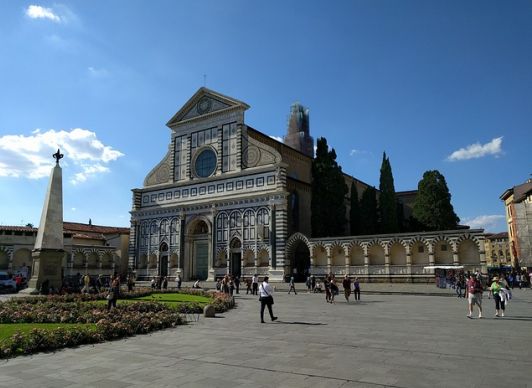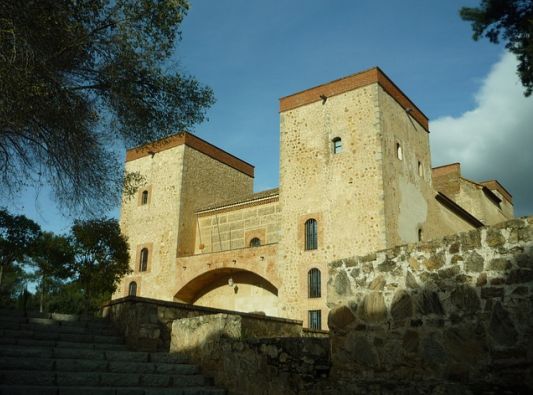Renaissance Architecture – Concept, Characteristics and Concept
Contents
Renaissance Architecture
This architecture was born in the XV and XVI centuries in Europe, having as basic elements the wall and the column. From there, the column always supports semicircular arches and the style of the most used capital is Corinthian and next to it appear Doric, Ionic and composite. Likewise, another element that characterizes it is the use of groin or barrel vaults, being the dome the most representative solution either to cover parts or the entire building. Likewise, the lintels, also widely used, are decorated with coffers. As for the materials used, brick, marble, and small masonry, being the ashlars in some cases cushioned. Another outstanding aspect of this architecture are the decorative elements, in which stand out aureas, in the form of a crown or border of laurel leaves, garlands, little lovebirds, grotesques, which are decorative motifs composed of fantastic beings with human, vegetable and animal forms complexly linked, the candelieri, inspired by the shape of the candelabra and balustrades.
Also important are the architectural elements of classical art such as pediments, entablatures. In relation to the plants, the medieval conception of longitudinal vision towards the high altar disappears, and the basilica plant is taken as a principle to reach the central plants that are more characteristic of Renaissance architecture. Thus, this architecture shows two approaches: the religious architecture, which uses the longitudinal or central plan with a wide interior in search of spatial unity. In which the clean and luminous wall prevails, without stained glass, with small windows that let in natural light, with a very careful exterior looking for beauty and interest in urban planning. While the civil architecture has greater importance with respect to the religious, highlighting the palace organized around a courtyard and facade articulated in three floors separated by cornices and topped with a large cornice, which is used in particular, the rigging of ashlar and opens to a large number of windows. Thus, what represents this architecture in its buildings are: the decoration, the styles of the capital, the groin or barrel vaults, the dome, the ashlars, the central floors, the clean wall, the courtyards with facades, the cornices and the numerous windows.

How was Renaissance Architecture born?
This architecture was born from a movement among architects seeking to break away from craftsmanship and make a more professional architecture, thus marking a personal style. Therefore, they created the classical and Renaissance humanist movement, which became accepted and well documented up to the present day. Thus its most important principles were: The classical ideal, looking to the Greco-Roman world as a model for contemporary society, applying in everyday material reality, the ideal rather than the real world. It was also characterized by the profane vision of religious themes, the classical religious values were considered pagan and sinful. The Natural, seen as the supreme creation of the work. Anthropocentrism and humanism, in which man is analyzed as the measure and reference of the universe.
How did Renaissance Architecture develop?
It had three periods: The early Renaissance in the fourteenth century and early fifteenth century, in which the figures of the architects Filippo Brunelleschi and Leon Battista Alberti stand out, this architecture is that of classicism that gives rise to the following period of the High Renaissance in which architects such as Donnato Bramante stand out, at the beginning of the sixteenth century. And Mannerism, which makes more evident the move away from the individual architecture, overcoming the classical theoretical project, and in it stand out the masters and geniuses such as Michelangelo, Andrea Palladio and Giulio Romano. Thus, what most characterizes this architecture is that the great Renaissance works are all signed. These architects were inspired by their own interpretation of classical antiquity, which they considered the perfect model of the fine arts. Thus art as a technique is manifested in a very compact project of synthesis and interdisciplinarity, with no consideration of independent elements but rather subordinated to the architecture.
How is Renaissance Architecture classified?
Renaissance ideals and values are somehow integrated to the medieval heritage that preceded it, however its concepts were built making a break with the production of the Middle Ages, particularly with the Gothic style. This rupture is reflected in the design of buildings based on more easily assimilated standards making an objective analysis of space, with empirical sense, reaching conclusions that would later impose the rhythm of the building itself and its environment. Thus the architectural intention is that the observer is dominated by space and instinctively raises his gaze to the sky in search of the figure of God. Hence the search for perfection in his designs and works.

The moments of this architecture are marked by the architects and their techniques. Such is the case of Brunelleschi, who is the creator of the perspectival system as a form of representation and investigation of reality, applying it to his works. He investigates the architectural elements of space by adopting classical elements such as standardization. He is the one who produced the beginning of Renaissance architecture in Florence. In the same way, Dramante who purifies the decorative forms of the Renaissance and prefers in his buildings the central plan of a severe and monumental style. Also with these architects there was the rediscovery of proportion and symmetry. Later, the Baroque movement emerged from Renaissance architecture, which sought to achieve an overall effect in its buildings. This is defined by its freedom in the use of the classical architectural lexicon, in it is evident the overflowing fantasy and the desire for movement. Thus, Baroque urbanism is a consequence of the need to order the development of cities and to express, through monumental architecture (buildings, squares, fountains, gardens), the power of the State and the Church.
What are the types of Renaissance architecture and the most representative examples?
What most characterizes Renaissance architecture are the great architects, represented mainly by Gian Lorenzo Bernini, Baroque architect, urban planner par excellence, who embodies better than anyone else the desire for greatness of Rome that recovers its spiritual and political supremacy. Francesco Castelli, who surpasses all Italian architects for his decorative invention and also used classical architecture, respecting proportions. He conceived architecture almost in terms of sculpture, being also in this current the genius of Michelangelo. In his magnificent works, noble materials such as marble stand out, the modification of the line, making the entablatures and cornices undulate, especially in churches as well as in government buildings. Inventing new forms for the capitals, using vaults that seem ribbed and mixtilinear arches, achieving pictorial effects on the wall by directing the light towards curved and broken surfaces. Some of the most representative monuments of this architecture are briefly described below:
The Medici Palace
It is located in Florence, Italy on the Via Larga, now Via Cavour. It has a Renaissance floor plan and the bedrooms are arranged around the courtyard. The use of cushioned ashlar was a symbol of wealth and power, as it was very expensive and difficult to make.
The Tea Palace
It is a palace located in Mantua, on the outskirts of Italy, a worthy representative of Mannerism.
The Pitti Palace
It is a Renaissance palace located near the Arno River in Florence, Italy, originally was the residence of the banker Luca Pitti.
The Uffizi Gallery
It is a palace and museum in Florence, which contains one of the oldest and most famous art collections in the world.
